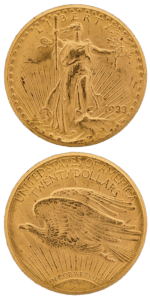The “Saint-Gaudens” Double Eagle

The 1933 Double Eagle was just the latest in a long line of $20 dollar coins that could trace their roots back to the California gold rush of 1848. Faced with the huge amounts of gold flowing back East that was powering the US’s rapidly expanding economy, Congress authorised the US Mint in Philadelphia, the nation’s chief producer of gold coinage, to issue larger denomination $20 gold coins in 1849. Containing nearly a full ounce of gold, these Double Eagles as they came to be known, symbolised the wealth, power and success of the emerging American nation.
For over half a century, their design remained unchanged, until in 1905, President Theodore Roosevelt, determined to produce an American coin of comparable beauty to those of Ancient Greece, the birthplace of democracy, and commissioned his friend, the renowned sculptor Auguste Saint-Gaudens to come up with a new design for the $20 coin.
He produced a design of breathtaking elegance and beauty. One side featured the advancing figure of Liberty, hair flowing, clasping the torch of Enlightenment in one hand and the olive branch of Peace in the other. Over her shoulder, the dome of the Capitol building symbolised Democracy, while there were forty five stars around the edge of the coin, one for each State at that time, and the date. (A forty sixth star was added in 1908 and a forty seventh and forty eighth in 1912, as the states of Oklahoma, New Mexico and Arizona came into existence.)*
The reverse featured a majestic flying eagle, together with the value of the coin and the US motto, “In God we trust”. Interestingly, Roosevelt believed that it was sacrilegious to have the word “God” appear on money, so ordered the motto to be omitted. Congress, however, which in 1866 had passed a law requiring all US coinage that was big enough to carry the motto, over-ruled him in 1908.
From the outset, though, it was a troublesome coin. Saint-Gaudens’ design, while magnificent, called for the coins to be struck in extremely high relief. This involved a lengthy and cumbersome minting process, requiring multiple strikes of the coining press and repeated heating and cooling treatments in order to achieve the desired effect. What’s more, because it wasn’t flat, the coin had the added inconvenience of not stacking properly, making it highly impractical to store and circulate.
The Mint’s chief engraver, Charles Barber complained and although the President, smitten with Saint-Gauden’s design, is said to have replied “I don’t care if it takes all day to produce one coin”, Barber eventually prevailed, modifying the design so that the coin could be struck in a single blow of the press as well as substituting Arabic for Roman numerals in the date. Saint-Gaudens died before any of his coins were produced.
Saint-Gaudens Double Eagles were struck from 1907 through 1933, when the Mint stopped issuing gold coins altogether following the passing of Executive Orders 2039 and 6102.
Design Specifications
Designer: Augustus Saint-Gaudens
Gross Weight: 33.346 grams
Net Weight: .96750 oz. pure gold
Composition: .900 gold, .100 copper
Diameter: 34 mm, reeded edge.
Click here to discover more about the 1933 Double Eagle and the circumstances that led it to becoming the most valuable coin in the world.
* Many thanks to Jerry Byram for clarifying this point.




